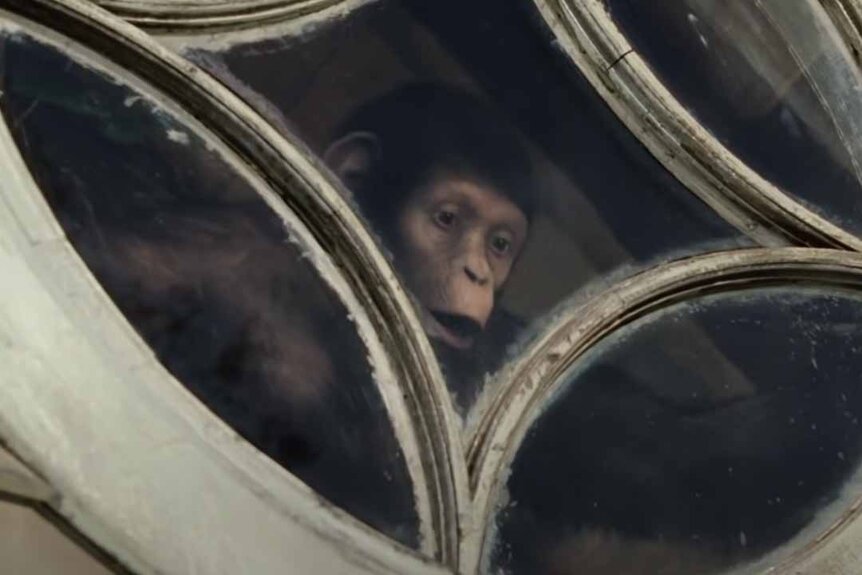Create a free profile to get unlimited access to exclusive videos, sweepstakes, and more!
Could We Create a Planet of the Apes on Purpose?
We kind of already have.
The Planet of the Apes series is, without question, the most well-known fictional example of animal uplift, the common name given to the practice of increasing non-human intelligence. In the 1968 original, a small crew of astronauts travel more than 2,000 years into the future and arrive on what they believe to be an alien world filled with intelligent apes and a subclass of subservient humans. In this version, the apes and humans changed naturally through the process of evolution. Two thousand years is a little short for that amount of biological and cultural change, but we’ll let it slide.
In the 2011 reboot, Rise of the Planet of the Apes (streaming now on Peacock), humans take a more direct role in the uplift of apes and the demise of our own species. Dr. Will Rodman (James Franco) is a scientist working on a cure for Alzheimer’s, the disease actively ravaging his own father’s mind. He develops an experimental compound called ALZ-112 and tests it on a chimpanzee named Bright Eyes, who passes it to her unborn son, Caesar (Andy Serkis). The next iteration of ALZ proves capable of uplifting all non-human apes while devastating the human population.
RELATED: The Version of Rise of the Planet of the Apes You Never Saw
The concept of animal uplift has existed in the popular consciousness since at least 1896, when H.G. Wells published his story The Island of Dr. Moreau. Other examples include 2001: A Space Odyssey (which involves the uplifting of human ancestors by an alien intelligence) and the dolphin character of Darwin on seaQuest DSV. Now, animal uplift is making its first tentative steps out of fiction and into the real world.
How Scientists Are Creating Clever Mice and Smarter Monkeys
While no concerted effort to increase the intelligence of non-human animals has been undertaken, a smattering of experiments have resulted in creatures who are seemingly smarter than they should be. There’s no question that humans exhibit a level of intelligence, communication, and environmental manipulation unmatched in the rest of the animal kingdom. The question is: What lies in our DNA that makes us different from our non-human siblings?
A 2014 study out of MIT utilized the human Foxp2 gene – identified as crucial to human language and learning – in a group of laboratory mice. The modified mice didn’t suddenly start reciting Shakespeare, but they did show measurably improved intelligence, demonstrated by a greater ability to navigate mazes. The aim of the study was to learn more about how Foxp2 helps to shape the human mind, and the mice were uplifted (as subtly as it might have been) in the process.
RELATED: The next Planet of the Apes film gets a title and a place in the timeline
Two years prior, researchers from Wake Forest University demonstrated that genetic changes aren’t the only potential road to improved intelligence. They used a neural prosthetic to ramp up brain activity and improve cognitive function. In their study, rhesus monkeys were spit into an experimental group and control group. The experimental group was given drugs to impair their brain function and the control group was left in an unaltered mind state. As expected, the intoxicated monkeys had poorer cognitive performance, until the prosthetic was activated. With the help of a neural prosthetic, the monkeys’ performance improved to normal levels. Additionally, when the device was activated in the absence of intoxicants, cognitive function rose to above normal levels. In short, the device appeared not only to undo brain impairment but also to improve baseline intelligence.
These experiments, and others like them, might suggest that non-human animal uplift is a foregone conclusion. Even if it’s not something we intentionally pursue, it might be an inevitable consequence of studies aimed at improving human health outcomes. The question then becomes whether we should use what we learn to intentionally modify wider animal populations.
Obligation or Error? The Ethical Debate Around Animal Uplift
"Could we" is one question, "should we" is another. If Rise of the Planet of the Apes is any indication, then uplifting non-human apes (not to mention other species) might be a recipe for disaster. Rather than something to be avoided, however, writer and bioethicist George Dvorsky argues we have an “ethical imperative” to uplift other species. To his way of thinking, it would be immeasurably selfish to have released ourselves from a violent Darwinian lifestyle, only to leave our non-human siblings to fend for themselves.
The other side of the debate notes a sort of human-centric thinking apparent in this idea. The notion that human-level intelligence is the end goal of existence, or at least inherently better than that of the “lower” animals. They also note that non-human animals cannot consent to such dramatic modifications to their being. And we can’t ask them afterward, because the thing they become will be dramatically different from where they started.
RELATED: Could apes build a society in 3,000 years? The science behind Planet of the Apes
There’s also the problem of getting there. While animals suffer in existing scientific research, the knowledge needed to change a chimpanzee into something like Caesar would likely require decades or centuries of intrusive, invasive research. Any effort to intentionally uplift a species will be built on a foundation of tremendous suffering. That might not be a legacy our chimpanzee or dolphin friends want to live with.
Today, we’re playing with one or a few genes at a time, tinkering with the biological recipe to see what each genetic ingredient does. We’ve learned that humans and chimpanzees are strikingly similar and overwhelmingly different, all at the same time. Increasing the intelligence of a chimp to the level of a human would require not just cognitive adjustments, but changes in the way they communicate, and the way they use their bodies. The resulting animal would not be a chimp with a better brain, it would be something chimp-like that we can’t really imagine.
Then again, we are something chimp-like, with just a few relatively small modifications, and therein lies the rub. The process of uplift would so dramatically change the target animal that you would lose it in the process. The result starts to look less like Planet of the Apes and more like Dr. Moreau, and that probably is something we should avoid.
In the end, uplifted apes are best left for the movies. Catch Rise of the Planet of the Apes streaming right now, on Peacock.



















